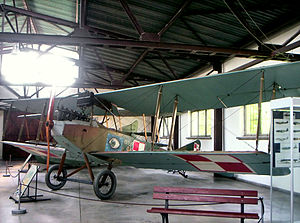| B.II | |
|---|---|
 An Albatros B.IIa in the Polish Aviation Museum | |
| General information | |
| Type | Reconnaissance aircraft |
| Manufacturer | Albatros Flugzeugwerke |
| Designer | |
| Primary user | Luftstreitkräfte |
| History | |
| First flight | 1914 |
The Albatros B.II, (post-war company designation L.2) was an unarmed two-seat reconnaissance biplane designed and produced by the German aircraft manufacturer Albatros Flugzeugwerke. It was the aircraft that brought Albatros Flugzeugwerke to the world's attention.[citation needed]
The design of the B.II, which included an unusually strong fuselage and an atypically flexible trailing edge, drew heavily upon the preceding Albatros B.I. Various measures were incorporated to elevate its usefulness as a reconnaissance aircraft, such as the presence of large square cutouts in the lower wing spars to increase downwards visibility from the observer's position. The pilot was seated behind the observer, rather than in front as later convention would dictate. In terms of flying performance, the B.II was inherently stabile and relatively docile, characteristics that naturally lent itself to the trainer role for which a dedicated variant, the B.IIA, would be developed. Further developments, including a floatplane and the Albatros B.III, would also be produced.
The B.II was active from the onset of the First World War, being operated by the Luftstreitkräfte during the opening year of the conflict primarily to perform aerial reconnaissance. It was displaced from frontline service due to the arrival of more capable armed reconnaissance types, and was then used as a primary trainer.[1] The B.II proved to be an export success, being adopted by multiple countries, both inside and outside of the Central Powers. Some of these overseas operators, such as the Swedish Air Force in 1919 and the Polish Air Force, continued to operate the type even after the Armistice of 11 November 1918 that ended the conflict.